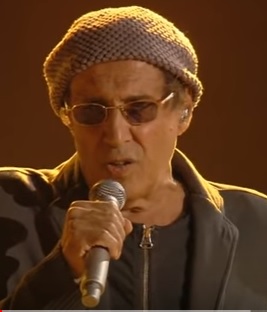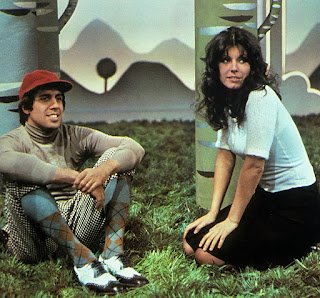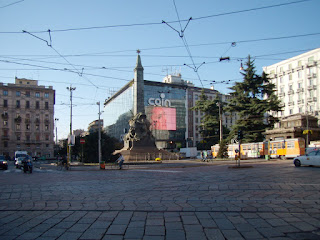Italy’s biggest-selling recording artist of all time
 |
| Adriano Celentano on stage in 2012 |
The pop singer and movie actor Adriano Celentano, who is
estimated to have sold in the region of 200 million records in a career
spanning 60 years, was born on this day in 1938 in Milan.
One of the most important and influential figures in Italian
pop culture, Celentano enjoys such enduring popularity that when he gave his
first live performance for 18 years at the
Arena di Verona in 2012, screened on the Canale 5 television channel, it
attracted an audience of more than nine million viewers.
He has recorded more than 40 albums, the latest of which,
Tutti le migliori (All The Best) reviving his collaboration with another
veteran Italian star, Mina, was released only last year and included new
material.
Celentano’s biggest individual hits include Stai lontana di
me (Stay away from me, 1962), Si è spento il sole (The sun has gone out, 1962),
Pregherò (I will pray, 1962), Il ragazzo della via Gluck (The boy from Gluck
Street, 1966), La coppia più bello del mondo (The most beautiful couple in the
world, 1967), Azzurro (Blue, 1968), Sotto le lenzuola (Under the sheets, 1971),
Ti avrò (I will have you, 1978) and Susanna (1984).
He also had an unexpected worldwide hit in 1972 with
Prisencolinensinainciusol – a made-up word that Celentano sung in such a way as
to demonstrate what American English – the language of most pop songs – sounds
like to a non-English speaking Italian.
 |
| Celentano, centre, with his 1950s band The Rock Boys |
Celentano also appeared in more than 30 films and countless
TV shows, mainly comedies, in which he developed a character with comic facial
expressions and a distinctive way of walking. It was no surprise that he was a
great fan of the zany American comic actor Jerry Lewis.
One of his earliest parts was in Federico Fellini’s classic La Dolce
Vita, in which he played a rock musician, while his most acclaimed role was in
Pietro Germi’s Serafino, in which he played a simple shepherd who inherits a
fortune from a wealthy art and squanders it all before returning to his old
life in the mountains.
Born in Milan in Via Cristoforo Gluck, in a modest neighbourhood near Milano Centrale station, Celentano grew up obsessed with the
American rock and roll scene. His early
music was pure rock and roll, heavily influenced by Elvis Presley, Little
Richard and Bill Haley, whose iconic track Rock Around the Clock was part of
the soundtrack of Blackboard Jungle, the film that captured the imagination of
Celentano and his fellow teenagers when it was released in 1955.
He and a group of friends formed a group The Rock Boys, who
recorded covers of Rip It Up, Jailhouse Rock, Blueberry Hill and Tutti Frutti. They are credited now with having introduced
Italy to the rock and roll genre.
 |
| Celentano with his wife, actress Claudia Mori, on the set of a TV show in 1972 |
As his career developed, he won the Sanremo Music Festival
in 1970 with Chi non lavora non fa l’amore (Who does not work does not make
love), in which he partnered his wife, Claudia Mori.
He had met Claudia, a beautiful actress and singer from
Rome, on the set of a film in 1963 and they married secretly in Grosseto the
following year.
Mori, who appeared with her husband in several films as well
as accompanying him in several duets, is the manager of his record company,
Clan Celentano. They have three children – Rosita, Giacomo and Rosalinda, all
born in the 1960s.
In the 1970s, Celentano was so popular and the demand for
tickets for his concerts so great he began to stage events at football
stadiums, playing to 65,000 at the San Paolo stadium in Naples and 50,000 at
the football stadium in Rimini.
He has several times taken long breaks from performing live,
in order to focus on other projects. After 14 years
without going on stage, he made a comeback of sorts in 2008 at the Giuseppe
Meazza Stadium in Milan – home of his beloved Internazionale – as part of the celebrations for the club’s
centenary.
 |
| Scene at the Arena di Verona for Celentano's 2012 concert |
It set the seed for him to plan his 2012 show in
Verona, where he demonstrated that his voice had lost none of its power and
sophistication, reeling off a string of his greatest hits from six decades of
music.
Increasingly a political figure – many of his songs carry
strong messages – he is a supporter of the centre-right Five Star Movement, led
by his long-time friend Beppe Grillo.
 |
| The Palazzo del Ghiaccio now stages events such as banquets in a uniquely striking setting |
Travel tip:
Adriano Celentano made his performing debut in 1957 at the Palazzo
del Ghiaccio (The Ice Palace), a beautiful Art Nouveau building in Via Piranesi,
in the Porta Vittoria area of the city. Opened in 1923, covering 1,800 square
metres, it was once the major covered ice rink in Europe and one of the largest
in the world. The building was seriously damaged during the Second World War
but was restored and reopened and remained an active venue for skating events until
2002. It has also hosted boxing, fencing and basketball among other sports, as
well as entertainment events such as the Italian Festival of Rock and Roll at
which Celentano took his first bows. His contemporary Mina played there for
the first time in 1959. The Palazzo is still an important venue today for fashion shows, exhibitions, business conventions, concerts and other events.
 |
| The Piazza Cinque Giornate in Milan |
Travel tip:
Porta Vittoria was formerly known as Porta Tosa, the eastern
gate of the Spanish walls of the city in the 16th century. It was
renamed Porta Vittoria with Italian unification in 1861 in respect of its historical
significance, having been the seen of a battle between Milanese rebels and the
occupying Austrian forces during the so-called Five Days of Milan in 1848. The actual gate was demolished in 1881 and
its location in what is now Piazza Cinque Giornate is marked with an obelisk
designed by Giuseppe Grandi.



